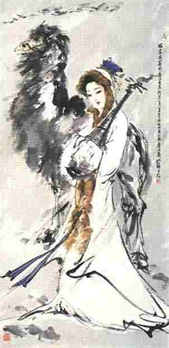Wang Zhaojun (王昭君, Wade-Giles: Wang Chao-ch?n, Pinyin: w?ng zhāo jūn) (b. before 33 BC - d. after 31 BC) was one of the Four Beauties of ancient China.
Wang Zhaojun, or Madame Wang Zhao, was born Wang Qiang (王嬙) in Zigui (秭歸), Nan Prefecture (南郡) (today Xingshan County (興山縣), Hubei) in the Western Han Dynasty. She became a maid (宮女) in the royal palace around 48 BC. She was a concubine of Emperor Han Yuandi of China, but she was never granted a chance to meet him. A widely believed reason is that Wang refused to bribe the royal painter Mao Yanshou, who then presented a less-than-flattering portrait of Wang whenever the emperor wanted to choose a concubine for the night. In reality, the reason may simply be there were so many women around the old emperor (who died a few months later after her departure from China).
In 33 BC, Huhanxie Chanyu (呼韓邪單于) of the Eastern Xiongnu requested to marry a Han Chinese princess from the Chinese Empire. The court agreed on the basis of the policy of heqin ("peace marriage"), but a woman needed to be found who was willing to go to the "barbarian" lands of the Xiongnu. Wang Zhaojun volunteered, and she finally revealed her beauty to the imperial court, which astonished the emperor and his ministers. It was too late for the emperor to change his mind, but in anger the emperor executed Mao and some other royal painters shortly after. Wang was honoured as Huning Eshi (寧胡閼氏 "Hu-Pacifying Chief-Consort").
According to some legends, she later married Huhanxie Chanyu's heir after the ruler's death following the tradition of Xiongnu. According to other legends, she commits suicide after her husband's death as her only resort in order to avoid marrying her son according to the practice of levirate.
Her life became the story of "Zhaojun Departs the Frontier" (昭君出塞). Peace was maintained for over 60 years between China and the Xiongnu. However, China eventually lost touch with her and her descendants.
Since the 3rd century the story of Zhaojun had been elaborated upon and she had been touted as a tragic heroine. The Communist government of the People's Republic of China uses her as a symbol of the integration of Han Chinese and ethnic minorities of China. Zhaojun Tomb still exists today in Inner Mongolia.
Notable retellings of the story of Wang Zhaojun include:
- Han Shu, Xiongnu Zhuan (first known account of Wang Zhaojun)
- Qin Cao ("Principle of the Lute") by Cai Yong (c. 2nd century)
- Xijin Zaji ("Sundry Accounts of the Western Capital") (c. 3rd century)
- Han Gong Qiu ("The Autumn in the Palace of Han") by Ma Zhiyuan (c. 13th century)
- Wang Zhaojun by Guo Moruo (1923)
- Wang Zhaojun by Chao Yu (1978)
Chapter 3, "Naturalizing National Unity: Political Romance and the Chinese Nation," of Nationalism and Hybridity in Mongolia by Uradyn E. Bulag (Oxford: Oxford UP, 1998) contains a detailed discussion of variants of the Wang Zhaojun legend.

